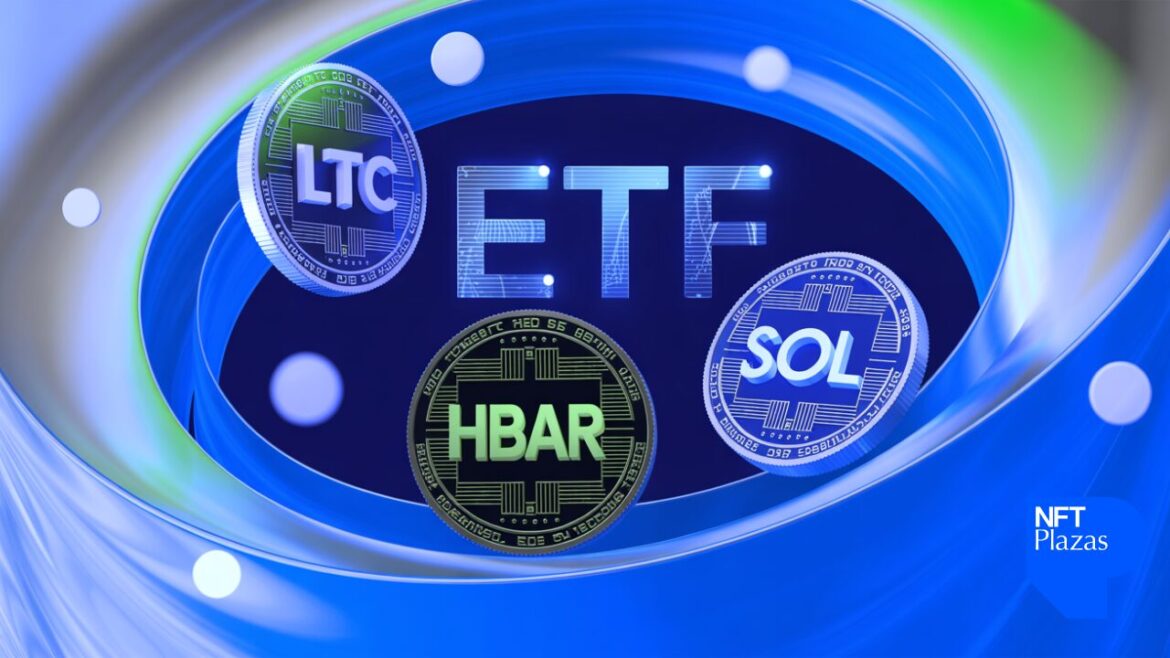The landscape of exchange-traded funds (ETF) in the cryptocurrency sector experienced a crucial shift in October 2025, moving beyond the established dominance of Bitcoin and Ethereum.
This period brought the debut of spot ETFs tracking several significant altcoins, most notably Solana (SOL), Litecoin (LTC), and Hedera (HBAR).
Altcoin ETFs Launch Despite the Shutdown
These new spot ETFs mark a critical expansion of regulated investment vehicles available to Wall Street participants. On Tuesday, October 28, 2025, an event underscored growing institutional acceptance of these digital assets as viable investments for those initiatives.
Crucially, the launches, including the Bitwise Solana Staking ETF (BSOL), Canary HBAR ETF (HBR), and Canary Litecoin ETF (LTCC), occurred during an ongoing U.S. government shutdown. Issuers utilized S-1 provisions and 8-A filings to achieve registration effectiveness automatically after the mandatory waiting period, bypassing the standard SEC review that the shutdown would otherwise halt.


Source: Blockworks
Learn more: Fed Policy: Two Rate Cuts Locked In, 2026 Remains Ambiguous
Solana’s Momentum and Competition
Solana, consistently ranking among the top cryptos by market capitalization, dominated the initial narrative.
Bitwise Sets the Pace
The Bitwise Solana Staking ETF (BSOL) supporting staking functionality, led the charge, starting with a strong initial asset size of approximately $220 million.
Initial trading figures on October 28, 2025, confirmed SOL’s dominance:
- The BSOL fund recorded $55.4 million in trading volume and $217.2 million in Assets Under Management (AUM).
- Bloomberg ETF analyst Eric Balchunas reported BSOL had the distinction of being the strongest ETF debut of 2025.
- Bitwise emphasized that BSOL targets 100% staking exposure, enabling investors to potentially gain a yield component through SOL’s average 7%+ staking rewards.
Confirmed. The Exchange has just posted listing notices for Bitwise Solana, Canary Litecoin and Canary HBAR to launch TOMORROW and grayscale Solana to convert the day after. Assuming there’s not some last min SEC intervention, looks like this is happening. https://t.co/bHwRnc1jsn
— Eric Balchunas (@EricBalchunas) October 27, 2025
Grayscale Enters Solana Competition
Following closely on Bitwise’s heels, asset management giant Grayscale also secured approval for the listing of its Grayscale Solana Trust ETF (GSOL). Grayscale received clearance to list GSOL on the NYSE Arca exchange, with trading expected to begin on Wednesday, October 29, 2025, the day following the initial launches.
By converting its existing closed-end trust, Grayscale immediately introduced a powerful competitor into the Solana ETF race. Analysts believe this high-profile listing will dramatically boost SOL’s liquidity and solidify its status as a premier institutional-grade digital asset.
LTC and HBAR: Lower Flows and Higher Fees
Canary Capital was the first to market with ETFs for Litecoin (LTC) and Hedera (HBAR), also launching on October 28, 2025. Canary CEO Steven McClurg highlighted the value proposition: LTC for its long-standing record of security and reliability, and HBAR for its position at the center of enterprise-scale digital asset utilization.
However, the initial reception for these two assets was more subdued:
- The Canary HBAR ETF (HBR) saw $8 million in trading volume on its first day.
- The Canary Litecoin ETF (LTCC) recorded $1 million in trading volume.
- The HBAR and LTC ETFs reportedly saw no net inflows or outflows on debut day, suggesting divergent investor awareness or conviction compared to SOL.
Furthermore, the management fee structure for the Canary products stood at 0.95%. This figure notably exceeds the lower averages seen in established spot Bitcoin ETFs, which often range between 0.15% and 0.25%. Market observers suggest that if investor interest remains robust, competitors are likely to introduce lower-fee alternatives to capture market share.
Shifting Narratives and Regulatory Precedent
The debut of these spot ETFs fundamentally broadens the investment narrative beyond simple price tracking. For instance, the Solana product incorporates staking mirrors, a trend where issuers actively seek features that align with the underlying blockchain’s functionality. Thus, this adds utility and potential yield to the traditional ETF wrapper.
Learn more: Crypto Regulation Wave in Southeast Asia – Vietnam Joins the Race
Building upon this foundation, the combined success of the SOL staking ETF and the prompt entry of major players like Grayscale will catalyze other asset managers to accelerate filings for additional established Layer-1 platforms. Therefore, this influx of regulated capital will profoundly impact liquidity, market accessibility, and long-term price discovery for SOL, LTC, and HBAR, ultimately structurally realigning how major digital assets integrate into mainstream investment portfolios.
Furthermore, the high trading volumes seen in the first wave will likely accelerate institutional scrutiny and capital flows toward promising mid-cap altcoins, particularly those with strong technical foundations.
Learn more: Citi Bank: Stablecoins Could Reach $3.7 Trillion by 2030
